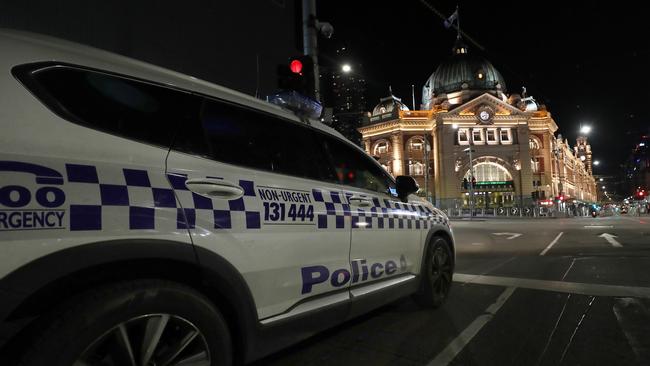Coronavirus: Suddenly, no one wants to call Australia home
Pitting state against state in a doomed bid to eradicate the virus will be the ruin of us all, all while we ignore the elephant in the room.

SA Premier Steven Marshall responded with a tourism video clip that mocked Andrews’s put-down. But his point was made more potently for him a few weeks later when Victorians were pursued, arrested and fined for fleeing across the border into SA, dodging police patrols bolstered by drones and helicopters intent on keeping Victorians out.
Melbourne-based Croweaters started returning to their home state and endured a fortnight’s isolation to escape an ominous coronavirus shambles in favour or an almost COVID-free existence.
Victoria’s 13,940 cases and 181 deaths dwarfs fewer than 500 cases and four deaths in SA. After allowing for population differences, Victoria’s toll is at least six times worse than SA’s.
In the AFL, Port Adelaide are now at the top of the table and the Adelaide Crows are at the bottom but everyone in the free-settler state feels they are winning the coronavirus challenge. So much for the federation, and so much for the national cabinet. In 2020, it is now every state for itself.
Thankfully, this is not absolute. During the week, Adelaide nurses flew out to put themselves in harm’s way in Victorian hospitals — but the essential truth is obvious. The response to this pandemic has exposed many of the weaknesses of federation rather than the strengths.
Despite the national cabinet, we have devolved, at least partly, into six colonies pursuing their separate interests.
Consider mendicant states such as Tasmania and SA, which are heavily subsidised economically by the larger states every year. Leading the charge on closed borders this year, they take additional federal subsidies to fund JobKeeper and JobSeeker payments, shutting out their fellow Australians while putting their hand out for even more of their cash.
And, sure enough, when Tasmania ran into strife with an outbreak, it called for federal help and eased its border restrictions to accept defence force assistance. Shunning the rest of the federation to keep the disease out; appealing to the federation when the problems arise.
When Scott Morrison generously threw together the national cabinet to co-ordinate the pandemic response, there was terrific co-operation between the states when it came to locking down society and accepting federal funding to support businesses and individuals. But when it came to fundamental decisions — such as keeping schools open or starting to ease restrictions — the states have tended to go their own way and resist Morrison’s urgings.
And, most consequentially, when the states were given the responsibility for funding and imposing quarantine on international arrivals, not all of them responded to the same level. The most crucial states (because of the numbers of arrivals) were NSW and Victoria; one used police to enforce quarantine, the other outsourced it to the private security industry.
We are all left to endure the consequences. (It is passing strange that the Socialist Left Premier should commit his most telling error through a penchant for outsourcing, while a right-of-centre government decided there are some tasks that government can do best).
This begs the question about the lack of national response and co-ordination. It exposes the impotence of the national cabinet and the fragility of the federation.
So one state had quarantine imposed by overseas students recruited as contractors via WhatsApp, absent any training in their specialist task, without accountability, receiving below award wages and figuring it might be okay to go shopping, share a smoke or even have sex with the people they were supposed to be isolating.
The other appreciated the import of the task and ensured its health authorities and police force provided the oversight required.
One state kept closed its schools and exacerbated the economic pain within its borders while other states followed the national medical advice and kept schools operational. One state accepted the responsibility of keeping society as open as possible by tracing and contacting all people affected by sporadic outbreaks and isolating them, while others shut their borders to keep the bogeyman away.
Listen to the premiers. The pandemic response is about Queenslanders, Tasmanians, West Australians, South Australians, Victorians, and New South Welshmen. Suddenly no one wants to call Australia home.
In NSW, the government has done its best to stop mass gatherings such as Black Lives Matter protests; in SA, they gave the protesters a permit; in Victoria, they stood back and watched thousands gather without arresting them, but later they were happy to arrest and fine people protesting against wearing masks.
As a nation, we gave ourselves a critical opportunity to consider our next steps. The Prime Minister and the premiers deserve praise for flattening the curve and buying us that time.
What is deeply troubling now is that, as a nation, we are no closer to deciding what to do next. We have one state under lockdown, others pulling up the shutters, and NSW seemingly the only jurisdiction trying to do what we all need to do — live with the virus.
Having written in these pages for months about sustainability — the need to find a pandemic response that can last — it is depressing to see politicians who seem to think that endless shutdowns, endless debt and endless welfare are a viable outcome. Andrews keeps talking about getting to “the other side” as if Victorians must simply endure a few weeks of pain before they are delivered into the land of milk and honey.
But it has been clear for months that we might need to consider a future where a vaccine is not available for years; or might never arrive. We need to return to our initial discussion of flattening the curve and ensuring that the demands of the pandemic do not outstrip medical capability.
We spent billions of dollars boosting capacity from less than 2500 critical care beds to 7500 so we could cope with the pandemic demand. But COVID-19 cases have never used more than 100 on any one day, and even now are using only about 50 beds at a time.
Either the coronavirus is not as bad as we thought, or we have changed our strategy from flattening the curve to eliminating it, abandoning any semblance of cost-benefit analysis. Perhaps we are doing the pandemic equivalent of banning cars to minimise the road toll.
So far, 85 per cent of Victoria’s fatalities and about 70 per cent of the national death toll have occurred in aged-care homes. Our extreme efforts to suppress community transmission really exist to keep the virus out of aged-care facilities — we should be searching for smarter and more sustainable strategies.
It is deeply worrying that we are not hearing more about a medium or long-term strategy. Most countries in Europe and North and South America would happily swap with Victoria’s COVID-19 performance let alone Australia’s.
But can we stay isolated from the world forever? Can we tolerate or afford more lockdowns? At what rate of infection do we maintain control of the health system and keep society functioning? How can we protect the vulnerable while freeing up the rest of society? At what level of exposure do we approach herd immunity? What are the best treatments for coronavirus infection?
It is unfathomable that these questions are not dominating national debate. But there was one glimmer of hope this week.
It might have taken a missive from the largely discredited World Health Organisation to prompt him, but the ABC’s medical guru, Norman Swan, who has led the alarmist, reactive, hard lockdown rhetoric, finally conceded that we might need to live with the virus. A vaccine might be a pipe dream.
“This the conversation I think that Australia has to have,” Swan told ABC breakfast television. “We are behaving, and governments are behaving, in the hope, you can just see it in their eyes, in the hope that there will be a vaccine sometime in the next six to 12 months and there is no guarantee of that — we all hope, there are some very promising results, but there may not be, it is not an easy bug to actually get a vaccine to — so what if there’s not? Is that sustainable? What are we prepared to tolerate? I don’t have the answers, but I think we need that national conversation.”
It was an echo of this column a fortnight ago: “We might wait years for a vaccine, or never see one. To prepare for that, we need economic policies and public health responses that are sustainable … As always, it is for politicians to carefully weigh up costs and benefits.”
When the ABC is simpatico with this column on policy imperatives, the case must be strong.




In the middle of June, with coronavirus on the wane, South Australia relaxed its hard border restrictions with some states but left them in place for Victoria. This revived a fierce interstate rivalry that once played out in AFL State of Origin clashes when Victorian Premier Daniel Andrews retorted; “Look I don’t want to be offensive to South Australians, but why would you wanna go there?”